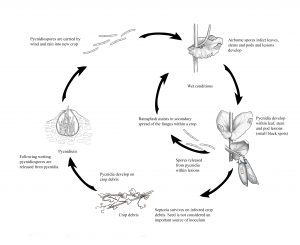Septoria blight is caused by the fungus Septoria pisi. Septoria blight is a minor disease and appears to have little effect on the yield of most pea varieties. The disease has been particularly noted in New South Wales but occurs sporadically in Victoria and South Australia. The disease is often seen on old foliage, pods and stems late in the growing season.
What to Look For
The disease is found mainly on the lower, senescing parts of the plant and the pods. The disease is characterised by yellow blotches on plant tissue, which become necrotic and covered in numerous brown spots. Lesions vary in size, are roughly circular and have no distinct margin. First they appear yellow later becoming straw-coloured. Several such blotches may join to cover the entire leaf. As the blotches dry out many pinpoint-sized black pycnidia (fungus fruiting bodies) may be seen scattered widely on infected plant parts, including pods. Diseased tissues may dry off prematurely.

Typical leaf and pod lesions caused by septoria infection. These blotches are brown and angular, containing very small brown to black spots.
Images courtesy Mary Burrows, Montana State University, Bugwood.org
Disease Cycle
The fungus over-winters on infected pea trash and seed. Spores of the fungus are carried by wind from infected trash into the new crop. Infection is found on the lower foliage where the humidity is high following rain or heavy dews. Disease development favours prolonged high humidity (at least 24 hours) and moderately warm temperatures of 21-27°C. Rain splash assists in spreading the disease within a field. Whilst seed-borne transmission can occur it is less important.
Management
Septoria blight can be managed through crop rotation. The septoria blotch fungus survives in soil and on old pea trash. It is only safe to re-crop an area with peas after all pea debris has decomposed. Destroying pea stubble by grazing, burning and cultivation will help in reducing the pea debris more quickly.



